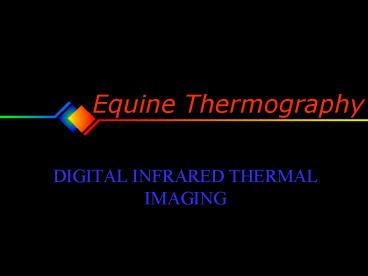DIGITAL INFRARED THERMAL IMAGING PowerPoint PPT Presentation
1 / 38
Title: DIGITAL INFRARED THERMAL IMAGING
1
Equine Thermography
- DIGITAL INFRARED THERMAL IMAGING
2
Sir William Herschel. Who discovered infrared
radiation 1800.
3
One of Herschels experiments to detect heat in
the spectrum.
4
Sir John Herschel. made the first thermogram in
1840. Using heat sensitive paper he charted the
suns movement across the sky.
5
We tried something similar ! The sun is the
greatest emitter of infrared radiation
6
The Infrared wavelength is from the visible to
the invisible range. The Emissivity from
living organisms is in the invisible range and
can only be measured with specialized infrared
detectors
7
- Thermography only records skin surface
temperature (5mm of microdermal circulation) - All thermal findings are produced by a
sympathetic response processed through the CNS - There is no direct conduction of heat or cold to
the skin surface - Thermography does not see structure or anatomy
- Thermography does show objective results relating
to the physiology of pain, pathology, injury and
dysfunction in any area of the body
8
Sympathetic preganglionic neurons are located in
the lateral horn (intermediolateral cell column)
of the spinal cord (A). Sympathetic
postganglionic neurons are located in the
paravertebral ganglia (B) and in the preaortic
ganglia. The adrenal medulla is a specialized
sympathetic ganglion (D).
9
(No Transcript)
10
(No Transcript)
11
Inflammation at any tissue depth will be
recorded by the sympathetic fibres in the
neurological supply to that area. This neural
information will be processed through the central
nervous system which will cause a sympathetic
response in the area of skin corresponding to the
affected site. The area of hyperthermia seen
thermographically at the skin surface is due to a
decrease of sympathetic motor tone (reduced
sympathetic function) allowing increased
blood-flow through the postganglionic sphincters
serving that area.
12
(No Transcript)
13
16 colors divided between an 8 C Range
14
Individual temperature measurements that are
accurate and sensitive to 0.01 (1/100th) deg C
15
A sound horse
Thermal Asymmetry of Lameness
16
Commonly Seen Shoulder Injuries
17
Commonly Seen Back Injuries
18
The normal foot in a sound horse
Local inflammation in a lame horse. Bruising
Local inflammation in a lame horse. Pressure
from a rotated distal phalanx
19
Isotherm, to localize inflammation
Palmar sole
A small puncture wound that had become infected
was found at the site of a focal area of
inflammation in a difficult to diagnose front
foot lameness.
20
Detecting tendon problems earlier improves the
outcome
21
Acute right medial hock injury
Chronic right medial hock injury
22
Deep digital tendon lesions
Superficial tendon lesion
23
(No Transcript)
24
Laminitis Shows a distinctive thermal signal in
the dorsum of the foot
25
(No Transcript)
26
(No Transcript)
27
(No Transcript)
28
(No Transcript)
29
(No Transcript)
30
(No Transcript)
31
(No Transcript)
32
Reports show objective thermographic findings
33
Differing colormaps can help with interpreting
and reporting
34
Indian Elephant with infection in the bed of the
nail of the fifth toe of the left front foot
35
(No Transcript)
36
Clinical Thermography is just a simple test of
physiology that relies on the sympathetic nerve
control of skin blood flow and the ability of the
sympathetic system to respond and react to
pathology anywhere in the body.
37
(No Transcript)
38
We can even do
Cat Scans

